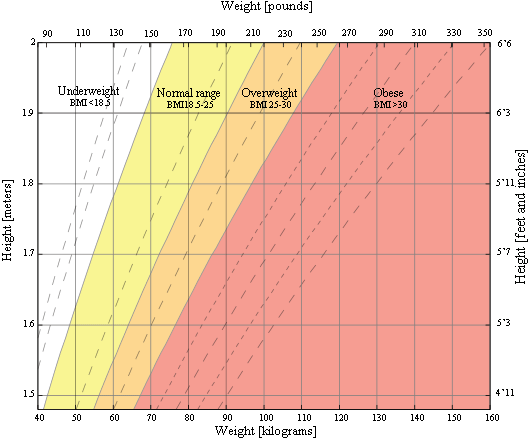Tags | |
UUID | fd855b40-696a-11ed-8f09-bc764e203090 |
The aim of BMI calculator is to calculate your Body Mass Index. According to (calculator.net, n.d.),The BMI (body mass index) is a computed number that represents a person's fat or obesity status. According to the Centers for Disease Control and Prevention (CDC), a BMI of 30 or above indicates obesity. BMI levels are broken down by weight range and are as follows: BMIs under 20 and over 25 have been associated with higher all-cause mortality, with the risk increasing with distance from the 20–25 range(Di Angelantonio et al., 2016). The interest in a body fat index arose as a result of rising obesity rates in rich Western societies. BMI, according to Keys, is appropriate for population studies but not for individual evaluation. Nonetheless, due to its ease of use, it has become commonly utilised for preliminary diagnostics (National Heart, Lung and Blood Institute,2014).
BMI < 18.5 is underweight
BMI 18.5-24.9 is normal weight
BMI 25-29.9 is overweight
BMI 30-39.9 indicates obesity
BMI >40 indicates morbid obesity
| category | BMI –Range Kg/m2 |
| Severe thinness | < 16 |
| Moderate thinness | 16-17 |
| Mild Thinness | 17-18.5 |
| Normal | 18.5 |
| Overweight | 25-30 |
| Obese class I | 30-35 |
| Obese class II | 35-40 |
| Obese class III | > 40 |
This is the World Health Organization's (WHO) recommended body weight based on BMI values for adults. It is used for both men and women, age 20 or older.
BMI charts for adults
Based on World Health Organization data, this graph depicts BMI categories. Subdivisions within a major categorization are represented by dashed lines.

BMI table for children and teens, age 2-20
| Category | Percentile Range |
| Underweight | <5% |
| Healthy weight | 5%-85% |
| At risk of Overweight | 85%-95% |
| Overweight | 95% |
Risk associated with being overweight
- High blood pressure
- Higher levels of LDL cholesterol, which is widely considered "bad cholesterol," lower levels of HDL cholesterol, considered to be good cholesterol in moderation, and high levels of triglycerides
- Type II diabetes
- Coronary heart disease
- Stroke
- Gallbladder disease
- Osteoarthritis, a type of joint disease caused by breakdown of joint cartilage
- Sleep apnea and breathing problems
- Certain cancers (endometrial, breast, colon, kidney, gallbladder, liver)
- Low quality of life
- Mental illnesses such as clinical depression, anxiety, and others
Risks associated with being underweight
- Malnutrition, vitamin deficiencies, anemia (lowered ability to carry blood vessels)
- Osteoporosis, a disease that causes bone weakness, increasing the risk of breaking a bone
- A decrease in immune function
- Growth and development issues, particularly in children and teenagers
- Possible reproductive issues for women due to hormonal imbalances that can disrupt the menstrual cycle. Underweight women also have a higher chance of miscarriage in the first trimester
Limitations of BMI
Although BMI is a popular and effective predictor of healthy body weight, it is not without limitations. BMI is merely an estimate that does not take into consideration body composition (calculator.net, n.d.). Because of the broad range of body types and the distribution of muscle, bone mass, and fat, BMI should be used in conjunction with other measurements rather than as the single approach for establishing a person's healthy body weight.
Reference
calculator.net. (n.d.). BMI Calculator. Www.calculator.net. Retrieved November 21, 2022, from https://www.calculator.net/bmi-calculator.html?ctype=metric&cage=25&csex=m&cheightfeet=5&cheightinch=10&cpound=160&cheightmeter=177&ckg=58&printit=0&x=62&y=29
Di Angelantonio, E., Bhupathiraju, S. N., Wormser, D., Gao, P., Kaptoge, S., de Gonzalez, A. B., Cairns, B. J., Huxley, R., Jackson, C. L., Joshy, G., Lewington, S., Manson, J. E., Murphy, N., Patel, A. V., Samet, J. M., Woodward, M., Zheng, W., Zhou, M., Bansal, N., & Barricarte, A. (2016). Body-mass index and all-cause mortality: individual-participant-data meta-analysis of 239 prospective studies in four continents. The Lancet, 388(10046), 776–786. https://doi.org/10.1016/s0140-6736(16)30175-1
Assessing Your Weight and Health Risk. National Heart, Lung and Blood Institute. Archived from the original on 19 December 2014. Retrieved 19 December 2014.
- Comments
- Attachments
- Stats
